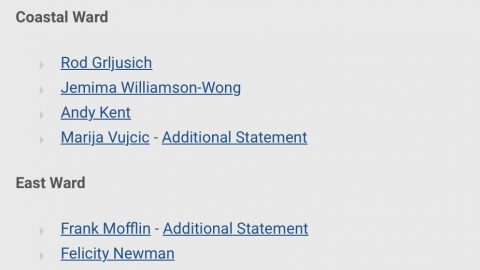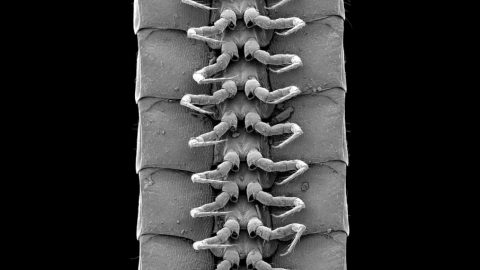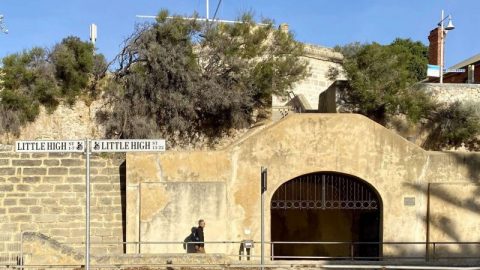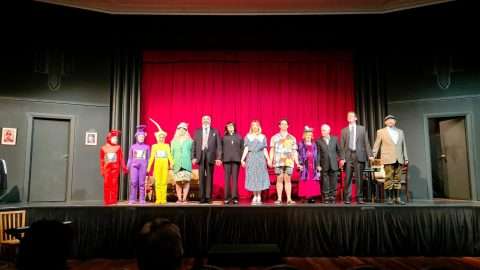Peregrinations of a Citizen Botanist, an ART ON THE MOVE touring exhibition by Fremantle artist Susie Vickery, is now on show at the Wanneroo Gallery as part of the Regional Exhibition Touring Boost. It runs until 15 October 2022.
The exhibition was first installed at Mundaring Arts Centre in 2019, and has since been touring the regions.
Hopefully, Freo qualifies as a region and the Botanist will arrive here sometime soon!
The Botanist is an immersive and finely crafted installation which takes the form of a cabinet of curiosities, charting the journey of the 18th Century French botanist Jacques-Julien Houtou de Labillardière, who came to Western Australia in 1792 on the ship Recherche, captained by Antoine Bruni d’Entrecasteaux.

The Botanist fully merged into the landscape. Credit Raquel Aranda
In her exhibition, Susie Vickery presents an alternative history of Labillardière’s journey, with the botanist gradually shedding his preconceptions as he encounters a rich and ancient land where his language and assumptions about the world fall away. At a time of accelerating climate crisis, this exhibition invites viewers to reflect on our relationships with home, history and environment, and by imagining an alternative past, to think creatively about possible futures.
This project has been made possible through the Regional Exhibition Touring Boost managed by the Department of Local Government Sport and Cultural Industries, supported by Royalties for Regions and delivered by ART ON THE MOVE. The Act-Belong-Commit Engagement Program presented by ART ON THE MOVE is sponsored by Healthway promoting the Act-Belong-Commit health message.
The idea of the Botanist exhibition so utterly fascinated the Shipping News when we learned of it, that we approached Susie Vickery to see if she’d tell us more about how it all came to be. Susie kindly agreed to respond to the questions of our editor, Michael Barker. Here’s the story.
1. Susie, how on earth did you come to discover Jacques-Julien Houtou de Labillardière?
When I came across him I hadn’t yet moved back to WA, where I had grown up. I was living in Mumbai and working with handicraft groups in Nepal, Tibet, Myanmar and Turkey. I wanted an ongoing personal art/craft project to travel with and also wanted to get back to my costume making roots. So I thought of making a puppet to travel with me, with a different outfit for each place we visited.
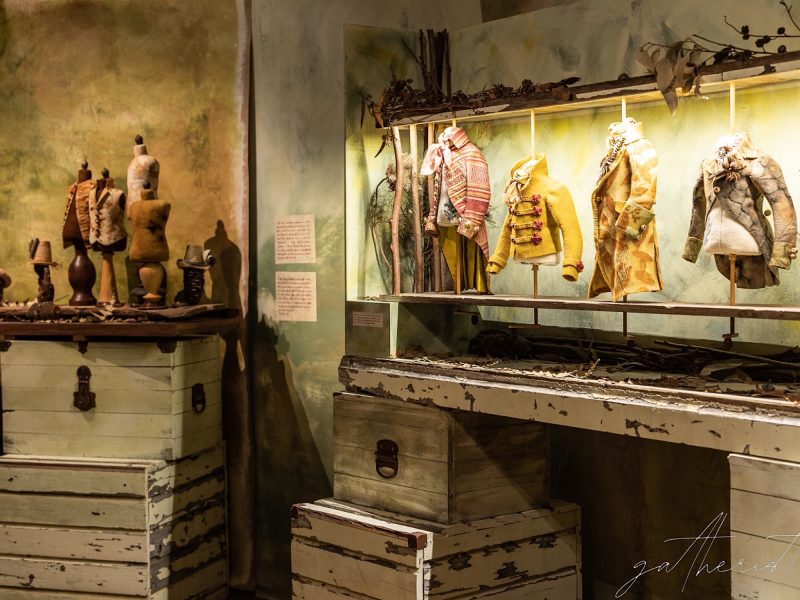
The Botanist’s wardrobe as he merges with the landscape. Credit Raquel Aranda
I would also make little films of him in these places. I thought that he would need to be a plant hunter to justify his travels, and French (great costumes). I had specialised in men’s 18th and 19th century costumes when I worked in London before that, so he was going to be from that period. I googled 18th century French plant hunters and came across Labillardiére and was amazed that he had been to WA. So I made his puppet and he travelled with me to these places.
Labillardière travelled with the d’Entrecasteaux expedition as one of the botanists on the ships the Espérance and the Recherche.
It was just after the revolution so the ship was divided between the royalist officers and the republican scientists and crew. This led to some discord. At the end of the expedition the French were at war with England and when they arrived in Batavia, they were all jailed, the Dutch being allies of the English. The officers got off more lightly than the crew, a lot of whom died.
All of Labillardière’s collections were taken and given to Joseph Banks. When Labillardière was finally released and made his way back to France he petitioned Banks to return them, which he did. Labillardière then published the first description of the flora of Australia – a copy of which is in the Stoke’s collection. Banks never published but is so much better known!
2. Susie, what was it about your discovery of J-J that led to the idea for your show?
I moved back to WA in 2017. In 2018 Jude Van de Merwe asked me to have an exhibition at Mundaring Art Gallery based on the Botanist. So it became my homecoming project, the Botanist and I returning after many years.
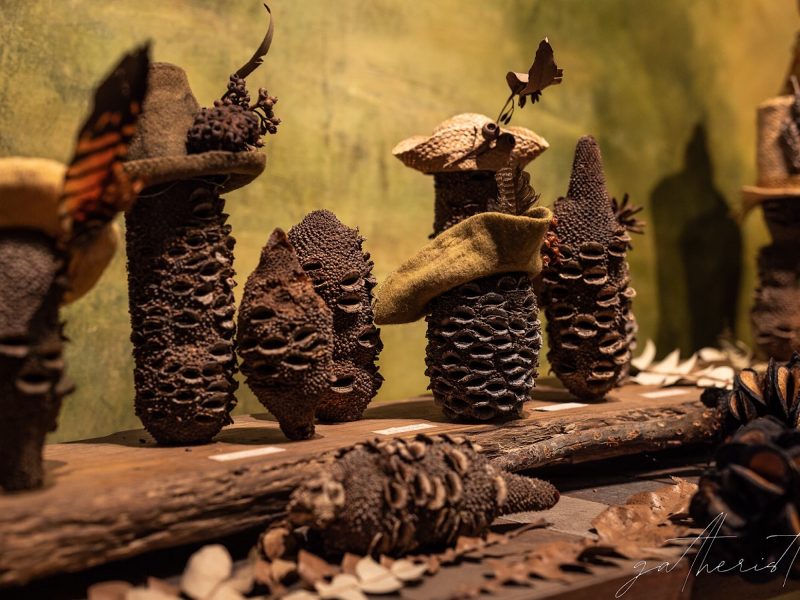
The Botanist’s collection of hats. Credit Raquel Aranda
I imagined the reality of someone coming back after over 200 years and seeing the changes to the landscape that we have wrought. How would they feel, especially if they were the first person to document and publish on the flora of this continent? I imagined him preferring to merge with the landscape, so his clothes change through the exhibition, becoming dyed and printed with the plants that he described.
3. What would you like people to take away from a visit to the Botanist
Coming back to WA, I realised how much I had to learn. I had no appreciation of how unique and vulnerable our flora is. At school we never learnt about Indigenous history or culture. We also only learnt the British history, nothing about French history, even though growing up I was surrounded by French place names. We all know who Banks was, but very few people have ever heard of Labillardiére.

The Botanist in his cabin, sick with scurvy. Credit Raquel Aranda
But the main thing that I want people to take away is how precious our environment is and how fragile. Everything that we do is impacting it. We need to tread as lightly as possible and learn from Indigenous land care and management.
And also to have fun and enjoy themselves.
4. Susie, out of interest, has J-J had any places round about the coasts named after him, like Bruni d’Entrecasteaux?
Not that I know of. I don’t think that the ‘Scientists’, botanists, geologists etc, on these expeditions had much named after them. It was always the officers and notable figures in their home countries who had their names spread around the globe. Sometimes plants were named after them, but it wasn’t the done thing to name anything after yourself. So the plants named after him have been given by other botanists.
5. Susie, this is all quite amazing. What is your own artistic background? You’ve hinted at some of it already.
Well, I worked as a theatrical costume maker initially here but later for many years in London. But in 1998, my partner and I moved from London to Kathmandu and I couldn’t make costumes anymore. So I started studying embroidery by distance learning, making art pieces with embroidery.

The Botanist’s boots. Credit Raquel Aranda
I particularly loved doing embroidered portraits, making embroidered automata and putting movement into my embroidered art with animation. And I like telling stories with my work.
6. So, just how did you go about conceiving of and making the figures and things in the show?
I had this idea to create a large interactive cabinet of curiosities to tell the story of the Botanist and follow him as he merged with the landscape. I love exhibitions where there are lots of things to discover and learn, so throughout the exhibition you can read historical information, extracts from his journal, and lots of plant names, traditional, Indigenous, and made up. There are drawers to open, handles to turn and pedals to pump.
I saw the exhibition as a collaboration, like the ship’s crew, but also a theatrical setting. I worked with lots of friends to create it. I have made a lot of little automata and wanted a big automata of his ship. I worked with Nathan Crotty to conceive this and he created this amazing automata based on a pianola.
Trish Bygott painted the beautiful backdrops to divide up the space and to set the scene.
Holly Story and Penny Jewell dyed and printed the fabrics for me.
Susie Rigg, a milliner who taught me at Perth Tech in the late 70s, made all the hats. (That course has since become part of WAAPA.)
And Kerry Fletcher composed the music after coming to see the show in Mundaring.
7. Susie, the exhibition has been ‘on the road’ a couple years now, just where has it toured and what has the reaction been?
After the Mundaring show in 2019, I applied to tour it with ART ON THE MOVE. It took us a year to develop it into a touring show that could go into different spaces and be strong enough to last the distance. Art on the Move were amazing with that, they have an incredible team.
It opened in Esperance which was brilliant as that is the one place in WA where J-J landed. Then it went to Carvarvon, Katanning, Albany, now Wanneroo and then Manjimup and Geraldton next year.
The exhibition has had a fabulous reaction, lots of interest as it appeals to all ages and genders as it has history, craft, science, and whimsy.
8. Is it coming to Freo, we do hope so?
Oh, so do I!
At the Mundaring exhibition Alec Coles came to see it and sent his curators. They thought that it would be good to show it in Freo’s Shipwreck Museum. But as it went on tour that idea was put on hold, so it is still a possibility when the tour finishes.
9. What happens with an exhibition like this when it eventually comes to an end? We assume it’s not so easily packed up and stored?
A good question! Fortunately, we have made a film about the making of the exhibition. My cousin, Emma Vickery directed it. At the Maker & Smith craft film festival we won the audience award for the film, and at the most recent Cinefest WA, a couple of weeks ago, we won the best WA short film award.
You can see the film right here!
And if you’d like to learn more about Susie Vickery’s art, here’s her website.
Exhibition details
When: On show from now to Saturday 15 October 2022 //10am to 4pm Wednesday to Saturday (closed Sunday and Public Holidays)
Where: Wanneroo Gallery, Wanneroo Library and Cultural Centre, 3 Rocca Way, Wanneroo
While you’re here –
PLEASE HELP US TO GROW FREMANTLE SHIPPING NEWS
FSN is a reader-supported, volunteer-assisted online magazine all about Fremantle. Thanks for helping to keep FSN keeping on!
** Don’t forget to SUBSCRIBE to receive your free copy of The Weekly Edition of the Shipping News each Friday!


